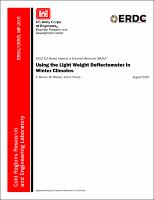Please use this identifier to cite or link to this item:
https://hdl.handle.net/11681/37674| Title: | Using the light weight deflectometer in winter climates |
| Authors: | Menke, Amelia M. Wieder, Wendy L. Shoop, Sally A. (Sally Annette) |
| Keywords: | Bearing capacity Pavement Snow Temperature |
| Publisher: | Cold Regions Research and Engineering Laboratory (U.S.) Engineer Research and Development Center (U.S.) |
| Series/Report no.: | Miscellaneous Paper (Engineer Research and Development Center (U.S.)) ; no. ERDC/CRREL MP-20-5 |
| Abstract: | The light weight deflectometer (LWD) was designed to test the compaction or bearing capacity of in-place aggregate base-course materials. This study evaluated the LWD at temperatures near and below freezing, below of its typical temperature range for road construction. Initial field LWD tests were run on a variety of compacted snow surfaces over asphalt pavement, gravel, and soil in the winter of 2018 in both Montana and Michigan. The LWD measures load and deflection, enabling calculation and backcalculation of stiffness parameters for the test surface layers. The field results were reasonable for the snow layers analyzed. However, the results indicated LWD may also have issues with the effects of low temperature testing on its components, specifically the rubber load buffers. Therefore, in the fall of 2018 a series of LWD tests were performed in cold rooms to evaluate the equipment without the variability of the snow surfaces as a parameter. This series of controlled tests determined that the LWD could be operated in conditions as cold as -25 °C. However, care must be taken in interpreting the results of tests conducted at cold temperatures. The ambient temperature and the duration of the LWD’s exposure to these conditions will affect the accuracy of testing. Significant changes in the LWD test results occurred after 24 hours of exposure to 0 °C, after two hours of exposure to -10 °C and after only one hour of exposure to -20 °C or a half hour of exposure to -25 °C. The LWD should not be stored in freezing temperatures prior to testing, and temperature and length of exposure should be monitored and recorded during field testing. |
| Description: | Miscellaneous Paper |
| Gov't Doc #: | ERDC/CRREL MP-20-5 |
| Rights: | Approved for Public Release; Distribution is Unlimited |
| URI: | https://hdl.handle.net/11681/37674 http://dx.doi.org/10.21079/11681/37674 |
| Appears in Collections: | Miscellaneous Paper |
Files in This Item:
| File | Description | Size | Format | |
|---|---|---|---|---|
| ERDC-CRREL MP-20-5.pdf | 629.49 kB | Adobe PDF |  View/Open |